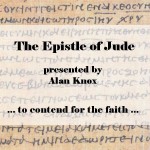How is New Testament Introduction Helpful?

As I mentioned a few days ago (see my post “Teaching Jude“), I am guest lecturing this morning on the topic of the Epistle of Jude. I am very excited about this opportunity, and hope that I have more opportunities to teach New Testament and New Testament Theology.
While preparing my lecture, I began to wonder how helpful New Testament introduction material is for the church. What do I mean by New Testament introduction material? Well, this is the outline of my presentation on the Epistle of Jude:
* Text and Transmission
* Canonical Status
* Authorship
* Similarities with 2 Peter
* Date and Destination
* Purpose
* The False Teachers
* Structure/Outline
* Theology
Concepts such as authorship, provenance, destination, date of writing, purpose, etc. are important in introducing the New Testament in a college, university, or seminary course. Are these ideas and concepts also important and helpful to the church?
What do you think?

Alan,
I do think these issues are helpful for fuller understanding of the text. For example, I find it extremely beneficial to know the background of what was happening in the churches receiving letters. Galatians is a good example. Knowing that certain teachers were influencing the Galatians away from the gospel helps the reader comprehend Paul’s forceful language right from the beginning.
Can someone understand the bible without the above concepts? Yes, I believe so. Can someone gain a fuller understanding if he has knowledge of the above factors? Yes again.
Eric,
Thanks for chiming in.
-Alan
* Text and Transmission
* Canonical Status
* Authorship
* Similarities with 2 Peter
* Date and Destination
* Purpose
* The False Teachers
* Structure/Outline
* Theology
Hi Alan, I pasted this here to make the commenting easier. If you are looking specifically at what will be helpful for a church as opposed to someone doing academic work, I do think your introduction structure could use some tweaking.
First the order. Starting off with things like text and transmission takes the reader out of the realm of, “I am preparing myself to hear from God as I read this.” Canonical status and Authorship begins to set up the intro as more authoritative than the actual scripture. I mean, the letter starts this way:
From Jude, a servant of Jesus Christ and brother of James. To those who have been called, who are loved by God the Father, and who are kept safe for Jesus Christ. (Jude 1:1)
For 99.9% the letter itself says it’s from Jude and to us, the church. They are good to go.
I think the things that are going to be helpful for those that want to just pick up the Bible and be ready to hear from God are:
Purpose
Date and Destination (you can just affirm authorship here)
Structure and Outline
Background (the false teachers in this case)
Even the Theology section, I would probably leave out, so that the reader can come to the text fresh and hear God teach instead of looking to find something he has been told to look for.
That’s just my 2 cents.
Stephen,
Thanks for the comment. I agree with most of what you said. I still think “Text and Transmission” is important. With the text, you don’t have any of the other stuff.
-Alan